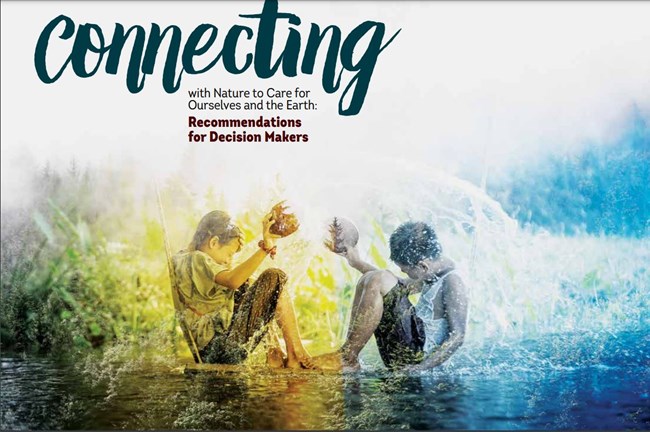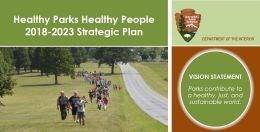For more information about how national parks are promoting health and wellness visit the Healthy Parks Healthy People home page.

Nature for All


The Healthy Parks Healthy People Science Plan is available for download. Developed with the engagement of academic researchers, health professionals, and federal scientists, it provides a framework and research agenda necessary to advance society’s recognition and reliance on the role of parks and protected areas in contributing to the nation’s health.


through a collaboration between the Center for Disease Control and Prevention’s Healthy Community Design Initiative and the National Park Service’s Rivers, Trails, and Conservation Assistance Program. This workbook assists communities in designing parks and trails that promote physical activity, reduce stress, and provide environmental benefits.

The Military Engagement Strategy is available for download. The National Park Service is committed to providing a robust array of opportunities for service members, veterans, and their families to experience parks as places of health and wellness, service and stewardship, education and recreation, employment and job skills training, and honor and celebration of their history and service. Through partnership and collaboration with the U.S. Department of Defense, U.S. Department of Veterans Affairs, and dozens of nonprofit organizations, the National Park Service will strive to achieve the goals and objectives outlined in this plan.

The NPS Active Transportation Guidebook is available for download. The National Park Service, in partnership with the U.S. Department of Transportation, is pleased to present the National Park Service Active Transportation Guidebook: A Resource on Supporting Walking and Bicycling for National Parks and their Partners. This tool supports National Park Service staff, local governments, community partners, and others to promote, encourage and implement responsible bicycle and pedestrian-friendly travel to and within national park sites.

Evidence Linking Parks & Health
Spending at least 120 minutes a week in nature is associated with good health and wellbeing.
Source: (White et al., 2019)
Viewing and spending time in nature lowers cortisol and blood pressure and is linked with lowering levels of stress, depression, and anxiety.
Source: (Bratman, Hamilton, Hahn, et al., 2015). (Cox, Shanahan, Hudson, 2017). (Bratman, Daily, et al., 2015). (Duncan, Clarke, Birch, 2014). (Haluza et al, 2014).
Exposure to nature has many physiologic benefits beyond mental health. Individuals exercise longer, more vigorously, and more regularly in green spaces and parks compared to other areas.
Source: (Gladwell, Brown, Wood, et al., 2013).
The AWE effect. Nature makes you more creative.Experiencing the wonder of nature can inspire people to solve problems more cooperatively and creatively.
Source: (Stellar, Gordon, Piff, et al., 2017). (Zhang, Piff, Iyer, et al, 2015).
Nature makes you more generous to others. Viewing beautiful nature scenes can result in people being more cooperative andgenerous to others, even in the presence of strangers.
Source: (Zelinski, Dopko, Capaldi, 2016).
Living near green spaces reduces mortality even when adjusted for socio-demographic factors.
Source: (Vienneau, Danielle et al., 2017). (Xu, Lixia et al., 2017). (James, Hart et al., 2016). (Gascon, Triguero-Mas, Martinez et al., 2016). (Brown, Lombard, Wang, 2016).
Access to parks is a social equalizer, addressing health disparities and benefiting people’s health and wellbeing.
Source: (Lachowycz and Jones 2014). (Wolch, Byrne, Newell, 2014). (Maas et al., 2006). (Mitchell and Popham 2008).
NPS Scientific Papers on Nature & Health Connection
Natural Solutions: Protected areas are vital for human health and wellbeing (Dudley N., Allen D., Campbell K., 2014).Benefits of biodiversity to human health and well-being. (Buttke, D., D. Allen, and C. Higgins. 2014. Park Science 31(1):24–29).
Park health resources: Benefits, values, and implications. (Thomsen, J. M., R. B. Powell, and D. Allen. 2013, Park Science 30(2):30–36).
Let’s Go to the Park Today: The Role of Parks in Obesity Prevention and Improving Public’s Health. Childhood Obesity 8(5):423-8 (Blanck HM, Allen D., Bashir Z, et al. 2012).
Parks Promoting Physical Activity: Synthesis of Findings from Interventions in Seven National Parks. Journal of Physical Activity and Health. 7 (Supp 1: 567-581). Hoehner CM, Brownson RC, Allen D. 2010.
Recommendation Reports & Guidelines for Health Promotion in Parks
National Physical Activity Guidelines for Americans, 2nd Edition (HHS, 2018).Routledge Handbook of NGOs and International Relations (T. Davis. 2018).
NPS Active Transportation Guidebook (NPS. 2018).
Connecting with Nature to Care for Ourselves and the Earth (Children and Nature Network, 2018).
Healthy Aging in Action Report (National Prevention Council. 2016).
The Natural Environments Initiative:Illustrative Review and Workshop Statement (2014).
Health, Recreation, and Our National Parks: Addressing the Role of National Parks to Promote and Provide Healthful Recreational Activities.(National Park Service Advisory Board Report. 2006).
Exploring Bicycle Options for Federal Lands: Bike Sharing, Rentals and Employee Fleets. (Federal Highway Administration U.S. Department of Transportation, 2012).
Navigate back to the Healthy Parks Healthy People home page.
Last updated: November 21, 2024
